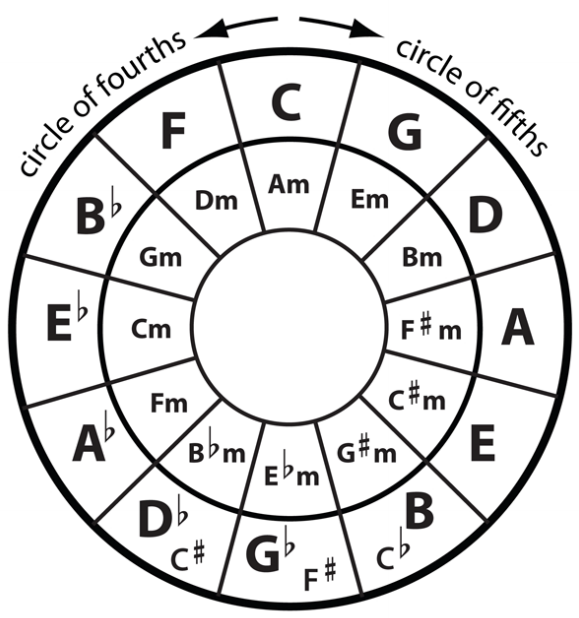If you’re interested in learning about the circle of fourths and fifths, then you’re on the right page.
The term circle of fourths or circle of fifths is common among musicians for a variety of reasons. The most common reason being its application in chord progressions.
It is because of the importance of the circle of fourths or fifths that we’re dedicating this lesson to it. But before we go into that, let’s discuss briefly on perfect intervals.
“What Are Perfect Intervals?”
One of the properties of an interval is inversion. An interval is said to be inverted when the order of the notes changes. For example, when the interval C and A:
…is played or spelled in such a way the A comes before C:
…an inversion is produced.
In a nutshell, the inversion of C and A:
…is A and C:
The inversion of an interval changes its quantity and quality. For example, C and A:
…is a major interval, while A and C:
…is a minor interval.
“Pay Attention To This…”
There are certain intervals that don’t change their quality when inverted and they are described as perfect intervals. When a perfect interval is inverted, it remains a perfect interval.
Major changes to minor
Minor changes to major
Augmented changes to diminished
Diminished changes to augmented
Perfect remains perfect
So, perfect intervals are unique because when they are inverted they still remain perfect. Their consistence explains why they are said to be perfect.
Perfect intervals include (but is not limited to):
The perfect unison
The perfect fourth
The perfect fifth
The perfect octave
However, we’ll be focusing on the perfect fourth and perfect fifth intervals briefly before we move on.
Perfect Fourth And Perfect Fifth Intervals
“Check Out All The Perfect Fourth Intervals On The Keyboard…”
C-F:
Db-Gb:
D-G:
Eb-Ab:
E-A:
F-Bb:
Gb-Cb:
G-C:
Ab-Db:
A-D:
Bb-Eb:
B-E:
“Check Out All The Perfect Fifth Intervals On The Keyboard…”
C-G:
Db-Ab:
D-A:
Eb-Bb:
E-B:
F-C:
Gb-Db:
G-D:
Ab-Eb:
A-E:
Bb-F:
B-Fs:
The Circle Of Fourths And Fifths – Explained
There are twelve musical notes – seven natural notes:
…and five accidental notes:
The circle of fourths and fifths:

…is a geometrical representation of all these notes in fourth and fifth intervals. There are two ways to consider the circle of fourths and fifths:
In a clockwise direction
In a counter-clockwise direction
The Clockwise Direction
The notes in the clockwise direction – C, G, D, A, etc., can either be considered as a geometrical representation of notes in fourths or fifths.
“The Circle Of Fifths…”
C:
…to G:
…is a fifth.
G:
…to D:
…is a fifth.
D:
…to A:
…is also a fifth, etc.
“The Circle Of Fourths…”
C:
…to G:
…is a fourth.
G:
…to D:
…is a fourth.
D:
…to A:
…is also a fourth, etc.
The Counter-Clockwise Direction
The notes in the counter-clockwise direction – C, F, Bb, Eb, etc., can either be considered as a geometrical representation of notes in fourths or fifths. Hence, it is known as the circle of fourths and fifths.
“The Circle Of Fifths…”
C:
…to F:
…is a fifth.
F:
…to Bb:
…is a fifth.
Bb:
…to Eb:
…is also a fifth, etc.
“The Circle Of Fourths…”
C:
…to F:
…is a fourth.
F:
…to Bb:
…is a fourth.
Bb:
…to Eb:
…is also a fourth, etc.
Final Words
That’s the much we can learn on the circle of fourths and fifths for today.
In subsequent lessons, we’ll go beyond this introduction into the application and memorization of the circle of fourths and fifths.
All the best!
Chuku Onyemachi
Latest posts by Chuku Onyemachi (see all)
- The Formation Of Diminished Seventh Chords Used To Be Challenging Until I Did This
- How To Form Seventh Chords In Two Shakes Of A Dog’s Tail Using Third Intervals And The Circle Of Fifths Chart
- I Played The 13sus4 Chord And This Happened…
- How To Build Seventh Chords Like An Architect Using “Foundation And Structure” Concept
- This 4-Week Plan Will Help You Master All The Major Scales







Comments on this entry are closed.